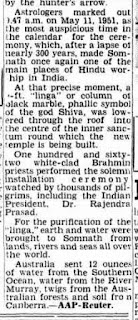Barog in Himachal Pradesh is famous for the longest tunnel on the Kalka-Shimla railway, but of late youtubers and trekkers have been descending on it to see an abandoned tunnel and the grave of the British engineer after whom the town is supposedly named.
It’s said that Col Barog – nobody seems to know his first name – was in charge of building tunnel 33. Because it is a very long tunnel – 3,752 feet long – he started digging it from both ends, but his alignment was wrong and the two parts didn’t meet.
Barog, the story says, was censured and fined a rupee. Humiliated, he walked up to the mouth of the flawed tunnel with his dog, and shot himself. Oddly, he was buried there, not in Dagshai, or Solan, or Kasauli, or Subathu. While the story is short on detail, even Barog’s “grave” has ghosted. Nobody has seen it in the past 15 years, at least. A team of Unesco observers that tried to find it in 2007 returned disappointed.
But the story doesn’t end there. While the place was named Barog in the colonel’s memory, and he took up residence there as a ghost, an Indian diviner named Baba Bhalku “helped” the British railway engineers find the right alignment of the tunnel. Full of gratitude for his service, the viceroy is said to have honoured him. Shimla city even has a railway museum named after Bhalku.
Barog before Barog
It’s a fantastic story waiting to be made into a movie, but there is a problem – Barog was called Barog even before work on the tunnel started. This excerpt from The Bombay Gazette of August 14, 1899 is proof:
“A detailed and final reconnaissance for the Simla-Kalka railway has now been completed by Mr Harrington (the chief engineer)….The proposed alignment will necessitate the construction of three important tunnels, viz. Koti spur...Barogh...and Tara Devi.”
Construction of the Kalka-Simla line didn’t start until the summer of 1900. And Barog figures again in a report from The Engineer of May 25, 1900:
“The first sod of the mountain railway from Kalka to Simla has just been turned….The heaviest parts of the undertaking are two large tunnels which have to be made….The second is the Barog tunnel, under the Solon Hill, about halfway to Simla.”
No mention of mistake, or delay
The same report in The Engineer says, “the tunnels are being taken in hand first as they will require upwards of two years to complete…” So, if tunnelling started in May 1900, the earliest it could have finished was in May-June 1902.
A report in The Railway Engineer of December 1902 says the two “headings” of the Barog tunnel were to have met on October 24, 1902 – comfortably close to the original estimate. Yes, the project missed the date, but even in December 1902 there was no sense of alarm or panic over the “delay”.
The report explains that work on the Barog tunnel was taking long because of natural obstacles. For example, its course lay through sandstone punctuated with springs: “The miners having had to work at times under deluges of water.”
Now, if the delay had been on account of a wrong alignment, would the press have glossed over it? Especially the railway and engineering journals? Wrong alignment would have meant a loss of many months, if not years, of effort.
Bhalku or compressed air?
In the legend, Bhalku pulls the tunnel project together with his sixth sense, but news reports from that time show it was a technologically advanced operation. In its May 11, 1901 issue, Indian Engineering talks about a “powerful compressed-air plant now being started” at the Barog tunnel.
Nineteen months later, The Railway Engineer of December 1902 confirms: “The work has been carried through with the aid of heavy air-compressing machinery got out expressly from England.”
Tunneling was only half the work. The tunnel also had to be lined with masonry, a slow job. Three years after work started on the tunnel, The Bombay Gazette of June 15, 1903 said, “The masonry lining of the great Barog tunnel is completed throughout all but 500 feet of its length.”
Not once does the name of Bhalku appear in these reports. It’s unlikely the press would have denied him credit just because he wasn’t white. It’s too good a story – a native diviner deciding the alignment of a railway tunnel – to suppress for racial prejudice.
Radio silence on colonel
The deadline for the Kalka-Simla railway was October 1903, and passenger services started on November 9, 1903. There was no delay. The Barog tunnel was completed within the overall project schedule. Coming back to Col Barog, is it possible that his “mistake” didn’t upset the project at all?
Also, why is there no report about his suicide in the papers from that time? A British colonel killing himself in India would have been a big deal. It would have been reported in not only India but also the UK and Australia. Yet, you find no mention of a Col Barog anywhere. He does not figure even in the project plans. Other people are listed in charge of work at Barog, Dharampur and Solan throughout.
Hence the question: how real is the ghost of Barog?
***















